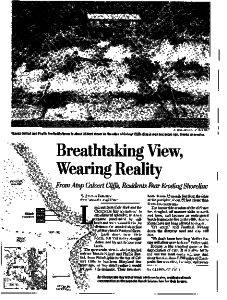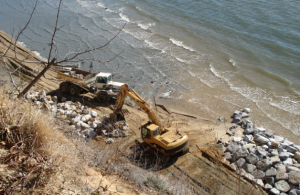As I have discussed in previous blogs, retirement is not without adversities, but the skills learned during our professional life can be used to our advantage. Our particular problem was to try and save our home from shoreline erosion. Our home was built in 1995 on a 70-foot cliff overlooking the Chesapeake Bay.

The Calvert Cliff’s clay level sloughed off from the high tides after Hurricane Isabel in Sept. 2003
In September 2003, Hurricane Isabel came up the Bay causing major property damage in Maryland. We didn’t realize it at the time, but our home would be severely impacted by Isabel’s effects. It happened over time — months and even years before the full impact became clear to us.
We did know after Isabel hit, we needed to apply to the State of Maryland for a wetland’s permit for shoreline erosion control. We applied for a “continuous nearshore breakwater.” Other names for this type of erosion control include jetty, riprap and revetment.
We worked with the Maryland Department of Natural Resources’ coastal engineer to design a breakwater that would most effectively control shoreline erosion at the base of the cliffs. It would be constructed using 500 to 2000 lb. granite stone carefully placed to a height of five feet. In total, the breakwater would be 165-feet long and 20-feet wide.
After submitting our application, officials with U.S. Fish & Wildlife Service and biologists with the state’s Natural Resources Dept. expressed their opposition to our permit. They were against homeowners on the Calvert Cliffs receiving any type of permit that would disturb the cliffs. Their reason: a “threatened” species, the Puritan Tiger beetle, had habitat on the cliffs and liked eroding sand. This particular tiger beetle is one of more than 100 species found in North America.
According to biologists, this beetle is only found along the Connecticut River in Massachusetts and on the Calvert Cliffs in Maryland. These two states have placed the P. tiger beetle on their endangered species list. Other Mid-Atlantic States have not done so and are not involved in efforts to save this tiger beetle.

The Washington Post featured our effort to work with county, state and federal officials to get a permit for shoreline erosion control.
Our application for a wetland’s permit began an odyssey that lasted two years. We joined with other homeowners on the Calvert Cliffs, but knew we were up against difficult odds. Homeowners had tried for years but the permitting process meant working through 17 county, state and federal agencies. We appeared before state legislative committees and wrote, talked and worked with local, state and federally elected officials.
To draw attention to our “endangered homes,” we contacted our local as well as Baltimore and Washington D.C. media. Our efforts yielded television, radio and print coverage, mostly sympathetic, including a major article in The Washington Post.
As we worked to get a permit, major slides continued to take vital land from our cliff. I have always considered myself to be an environmentalist and have even worked for an environmental organization. But I do not believe a beetle should take precedent over the safety of homeowners and their property.

Coastal contractors used heavy road equipment to build the nearshore breakwater with 500 to 2000 lb. granite stone.
As you can imagine, I learned more about the Puritan tiger beetle than I had ever expected or wanted to know. I learned its numbers are so low, long-term survival is suspect and between 2000 and 2007 Maryland provided no funding to rehabilitate the species.
Our permit went all the way to the U.S. Attorney General’s office before it was finally issued in December 2006. We were the first on Maryland’s western shores to secure a permit for a nearshore breakwater. Between January and March 2007, our coastal contractor hauled granite stones to the base of our cliff to build the breakwater.

Our nearshore breakwater completed in March 2007.
The finished breakwater is 165 feet long by 20 feet wide and five feet high. My sister’s comment, “that’s a lot of counter tops!”
Even before the breakwater was built, we knew the amount of erosion caused by Hurricane Isabel had severely weakened our cliff. We knew we might not be able to stay in our home as long as we wished, but the fight was worth it. Not only for our property, but for other homeowners on the Calvert Cliffs. After the breakwater was completed, often we would see fisherman sitting on the rocks casting their line into the water. Over the years as algae grew on the stone, we would imagine all the aquatic life feeding in the area.
Since we built our breakwater, five more homeowners secured permits and are able to help save their homes. The Bay provides a lifestyle unlike anything we have ever experienced. We are grateful for every day we lived at the Chesapeake Dream.
The Takeaway: They say adversity makes you stronger, but most of us don’t appreciate such test. I know, I don’t. What unexpected experiences have you had in retirement or preparing for retirement? What is your takeaway from these experiences? Let me know at [email protected]
